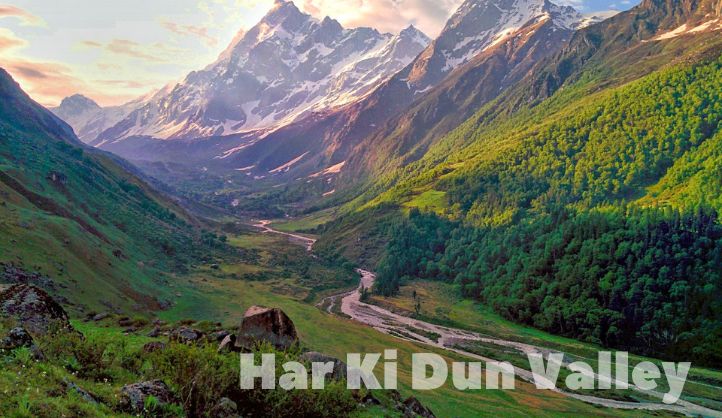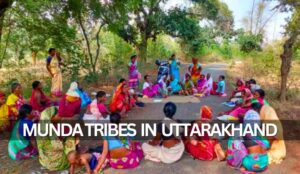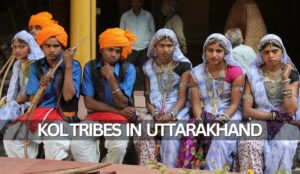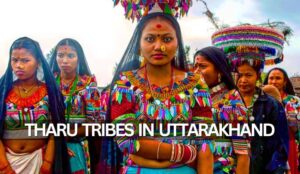About Har Ki Dun Valley:
- Location:
- Har Ki Dun Valley is nestled in the western Himalayas, situated in the Uttarkashi district of Uttarakhand, India.
- Geographical Features:
- Surrounded by snow-capped peaks, the valley is characterized by lush greenery, alpine meadows, and the Supin River flowing through its heart.
- Accessibility:
- Accessible through a trek that begins from Sankri, the journey to Har Ki Dun showcases the pristine beauty of the region.
- Flora and Fauna:
- The valley is rich in biodiversity, home to a variety of flora and fauna, including orchids, coniferous forests, and diverse wildlife.
History of Har Ki Dun Valley:
- Ancient Connection:
- Har Ki Dun has historical significance, believed to be one of the oldest inhabited areas in the Indian Himalayas.
- Cultural Influence:
- The valley has cultural ties to the Mahabharata era, and local legends associate it with the Pandavas and their journey to heaven.
- Nomadic Settlements:
- Historically, the valley has been inhabited by nomadic communities, and their unique way of life adds to the cultural richness of the region.
Why is Har Ki Dun Valley Famous:
- Natural Beauty:
- The valley is renowned for its breathtaking natural beauty, offering panoramic views of snow-capped peaks, glaciers, and meadows.
- Trekking Destination:
- Har Ki Dun is a popular trekking destination, attracting adventure enthusiasts seeking a trek that combines natural splendor with cultural experiences.
- Cultural Significance:
- The valley’s historical and cultural significance, coupled with its natural charm, contributes to its fame among travelers.
Things to Do in Har Ki Dun Valley:
- Trek to Har Ki Dun:
- Embark on a trek to Har Ki Dun, a journey that takes you through picturesque landscapes, quaint villages, and dense forests.
- Explore Osla Village:
- Visit Osla, a charming village known for its traditional wooden houses, ancient temples, and warm hospitality.
- Photography and Bird Watching:
- Capture the scenic beauty on camera and indulge in bird watching, as the valley is home to a variety of avian species.
- Camping in the Meadows:
- Set up camps in the alpine meadows, experiencing the tranquility of the surroundings under the starlit sky.
- Connect with Local Culture:
- Interact with the locals, learn about their customs, and experience the unique culture of the region.
Things to Know about Har Ki Dun Valley:
- Geographical Location:
- Har Ki Dun Valley is located in the Uttarkashi district of Uttarakhand, India, situated in the western Himalayas.
- Topography:
- Surrounded by majestic snow-capped peaks, the valley boasts alpine meadows, dense forests, and the gentle flow of the Supin River.
- Access Point:
- The journey to Har Ki Dun begins with a trek from Sankri, a base camp that sets the stage for the exploration of this scenic valley.
- Biodiversity:
- The valley is a haven for biodiversity, featuring a range of flora, including orchids and coniferous forests, and is home to various wildlife species.
How to Reach Har Ki Dun Valley:
- By Air:
- The nearest airport is Jolly Grant Airport in Dehradun. From there, one can hire a taxi to Sankri, the starting point of the trek to Har Ki Dun.
- By Road:
- By Rail:
- The nearest railway station is Dehradun Railway Station. From here, one can hire a taxi or use public transportation to reach Sankri.
- Trekking Route:
- The trek to Har Ki Dun Valley usually starts from Sankri, and various trekking agencies organize guided treks with different durations.
Travel Tips for Har Ki Dun Valley:
- Physical Fitness:
- Due to the trekking involved, it is advisable to be in good physical condition. Regular exercise before the trip can enhance trekking endurance.
- Pack Wisely:
- Pack essentials such as comfortable trekking shoes, warm clothing, a raincoat, a first aid kit, and other necessities for a trek in varying terrains.
- Local Customs:
- Respect local customs and traditions. Seek permission before taking photographs of people and their homes.
- Altitude Considerations:
- Har Ki Dun is at a considerable altitude, so acclimatization is crucial. Take breaks during the trek to adjust to the changing altitude.
- Guides and Permits:
- Consider hiring a local guide for the trek, and ensure you have the necessary permits, especially if the trek extends to Govind National Park.
Best Time to Visit Har Ki Dun Valley:
- Summer (April to June):
- The weather is pleasant during this time, with blooming flowers and greenery, making it an ideal period for trekking.
- Post-Monsoon (September to November):
- After the monsoon, the valley is rejuvenated, offering clear skies and vibrant landscapes, making it another favorable trekking season.
- Winter (December to March):
- Winter transforms the valley into a winter wonderland, but it’s a challenging time for trekking due to heavy snowfall.
Places to Eat Near Har Ki Dun Valley:
- Sankri Food Joints:
- Savor local and North Indian cuisines at eateries in Sankri, the base camp for Har Ki Dun trek.
- Taluka Village Cafes:
- Enjoy simple yet delicious meals at the cafes in Taluka village, a picturesque spot along the trekking route.
- Osla Dhabas:
- Osla, known for its traditional wooden houses, offers dhabas serving local cuisine, providing a taste of the region’s flavors.
- Har Ki Dun Campsite Meals:
- Relish meals prepared by the campsite staff during the trek, offering a mix of energizing and local dishes.
- Purola Street Food Stalls:
- Purola, a town on the way to Sankri, has street food stalls where you can grab quick bites before or after your trek.
Nearby Places Har Ki Dun Valley:
- Ruinsara Tal:
- A high-altitude glacial lake near Har Ki Dun, offering stunning views and an additional trekking destination.
- Morinda Tal:
- Another serene lake nestled in the Himalayas, providing a tranquil spot for nature enthusiasts.
- Harkidoon Temple:
- Visit the Harkidoon Temple, dedicated to Lord Shiva, and experience the spiritual ambiance amidst the mountains.
- Siyan Gad:
- A pristine location surrounded by snow-clad peaks, offering a serene escape for those seeking tranquility.
- Deoban:
- A vantage point providing panoramic views of the Garhwal Himalayas, perfect for photography and relaxation.
Conclusion for Har Ki Dun Valley:
In conclusion, Har Ki Dun Valley stands as a testament to nature’s grandeur, offering a unique blend of cultural richness and scenic beauty. From the trekking trails to the nearby serene lakes and temples, the valley captivates adventurers and nature lovers alike, making it a destination worth exploring.
Frequently Asked Questions (FAQs) about Har Ki Dun Valley:
Q: How do I reach the base camp for Har Ki Dun trek, Sankri?
A: Sankri can be reached by road from Dehradun or Mussoorie. Regular buses and shared taxis are available.
Q: What is the best time to visit Har Ki Dun Valley?
A: The best times are during the summer months (April to June) and post-monsoon (September to November).
Q: Are there eating options during the trek to Har Ki Dun?
A: Yes, there are food joints in Sankri, Taluka, Osla, and campsite meals are provided during the trek.
Q: What are some nearby places to explore from Har Ki Dun Valley?
A: Nearby attractions include Ruinsara Tal, Morinda Tal, Harkidoon Temple, Siyan Gad, and Deoban.
Q: Are there any altitude-related concerns for the trek to Har Ki Dun?
A: Yes, acclimatization is crucial due to the altitude. Take breaks during the trek to adapt to the changing altitude.






